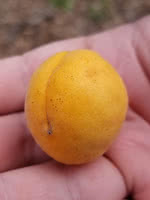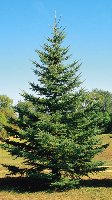Mon-Fri 9am - 5pm Mountain time
Black Hills Spruce vs Manchurian Apricot
Prunus armeniaca var. mandshurica
Picea glauca var. densata
Manchurian Apricot is a winter-hardy relative of the native plum. This tree can stand some drought, but will not handle standing water or saturated moist soils. It can be used in shelterbelts, hedges, or as an ornamental. Manchurian Apricot will also attract songbirds, rabbits, and other rodents if left uncontrolled.
This tree will produce fruit once it reaches maturity at between two and five years old. Other famous cultivars of Manchurian Apricot include Scout Apricot, Moongold, and many more.
Black Hills Spruce is a subspecies of White Spruce native to the Black Hills of South Dakota. It has a strongly conical form, slower growth rate and denser foliage than typical white spruce, making it preferable as a specimen tree for smaller suburban lawns. It also responds well to pruning, and can be used as a hedge or even bonsai.
Manchurian Apricot Quick Facts
Black Hills Spruce Quick Facts
In row spacing: 3 - 4 m (10 - 12 ft)

